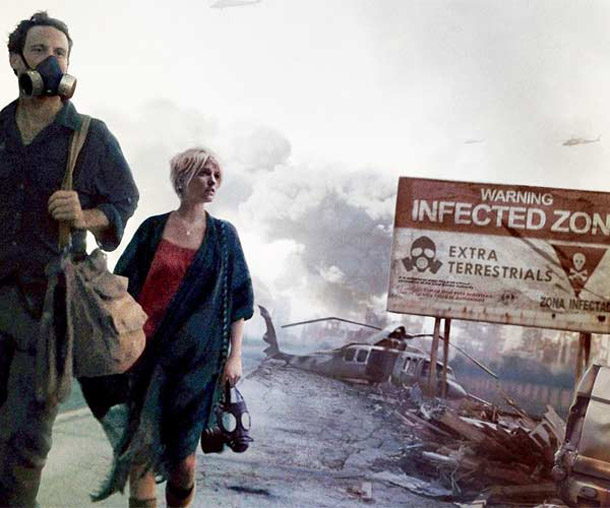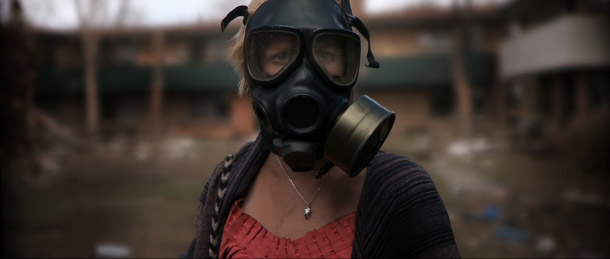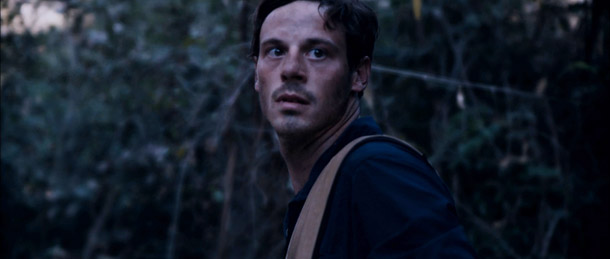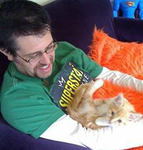Monsters Exclusive
None
SFX talks exclusively to Gareth Edwards, director of Monsters , the low budget British SF film that causing a major stir

Monsters is an amazing filmmaking achievement. That’s regardless of whether you like it or not. SFX does, a lot. Some people don’t. That may be because its title and the fact that lazy journalists have been calling it, “This year’s District 9 ” lead you to think it’s going to one kind of movie, when in fact it’s something quite different. As director Gareth Edwards admits, “It has more in common with Motorcycle Diaries than District 9 .”
Yep, it’s a relationship movie.
It just happens to be a relationship movie that takes place in a world where monsters exist.
It’s a bit like there‘s a traditional monsters movie taking place just over the horizon, while we get to see the story of two characters travelling on the fringes of the action.
But that’s not the only thing that makes the film so amazing. The really amazing thing was the way it was made, on a budget that redefines the concept of shoestring. Edwards dismisses the oft-quoted cost of $15,000 (“I think someone’s basing that on how much the equipment came to”), putting the budget more realistically at “somewhere in the low six figures”, but even that is seems mind-boggling low when you see the images he puts on screen.
Monsters is released on 3 December. On the following pages we give you a bit of an insight into the genesis and making of this extraordinary film. And on the final page you can discover how to get discount discounts for th film on the day of release at selected cinems.
Weekly digests, tales from the communities you love, and more
.
.
1 The breakthrough
A former CG visual FX technician who worked on various British TV and film projects before trying to break his way into directing (“I was sacked from Attila the Hun ,” he recalls with an wry grin of his struggle to make the transition), Edwards’ first big breakthrough was winning Sci Fi London’s 48-Hour Film Challenge a couple of years back with a short film called Factory Farmed . “It was a title that was given to us. They give you a title, a line of dialogue and a prop and you have to come back within two days with the final five-minute film. It partly just to prove that you hadn’t made the film already. Thankfully it snowed on the day. It was the only day it snowed. So that was proof. Anyone who didn’t have snow in their film, you’d be suspicious about when they filmed it.”
.
.
2 The Inspiration
The idea for Monsters came when Edwards was on a fishing trip, watching fishermen hauling in their nets, and he started wondering, “What if they’d caught a huge, alien sea monster?”
He always knew, though, that on the kind of budget was going to be working with, a traditional action movie was out of the question. “I never intended to do a relationship movie – in fact I hate relationship movies – but as I tried to work out the angle to take, it was the relationship between the two lead characters that was the obvious way to go. So the trick then was making a relationship movie that I would want to go and see.”
The result is the story a photo-journalist on a gig in South America, attempting to photos of monsters that have been roaming a “forbidden zone” since they hitched a ride back on a Earth spaceship which crash landed on its return a few years previously. Instead, he’s forced by his boss to find his daughter – who’s also in Mexico – and escort her back to safety.
“I wanted to do an angle on a monster movie that hadn’t been done before. It’s much more about atmosphere than visual spectacle.”
He managed to sell the idea to Vertigo Films, for whom he has nothing but praise for the faith they put in him, though he ironically points out: “Initially they were like, ‘Well, we obviously think you can do the special effects, but can you handle the storytelling?’ After we shot the film and I came back and had to do all the special effects, they were going, ‘Well, you can obviously handle the live action, but are you going to able to deliver the effects?’”
.
.
.
3 Guerrilla Filmmaking
The actual shoot for Monsters was the very definition of guerrilla filmmaking. It didn’t even have a proper script. Edwards, a skeleton crew and his two lead actors – Whitney Able and Scoot McNairy, the only real actors in the movie – travelled to various South and Middle America (Costa Rica, Belize and Mexico amongst others) with a vague script outline and a scene breakdown, then literally improvised the scenes (“I wanted some idiot dialogue in the film,” says Edwards. “I didn’t want it sounding scripted”). They didn’t even have specific locations in mind. They would simply drive around and shoot when they found suitable locations.
“The ‘script’ had some pages with the text in black – which meant that an action sequence was required – and some blue, which meant it was an emotional scene,” explains Edwards.
This meant a lot of opportunism. Some scenes were even shot twice in different locations and a lot of footage was shot that was never used.
“There were some scenes that were great, but they just did not fit into the film,” says Edwards. “One in particular – we were driving through Belize, and we came across this amazing park with these giant mountains in the background. We jumped out and started filming a scene, but we didn’t know what that scene would be. We kinda just ad-libbed it. Figured it out as we went along. It’s a great little moment between Whitney and Scoot. He’s trying to fix his camera because it’s broken and he can’t fix it. And she’s bored and she’s got a piece of grass in her hand and she’s tying it round her finger to make a ring.
“I really liked it as a scene. But when it came to putting it in the film, it didn’t go anywhere. If we put early in the film, there was no reason for them to be in a location that remote, and if we put it later in the film the tone would have been all wrong; they would have been more stressed. That’s the sort of thing we’ll put on the DVD and explain why we didn’t use it. There are quite a few things like that.”
.
.
.
4 Using Locals As Extras
Aside from the two leads, all the other “roles” in the film were played by locals that Edwards found on their travels. Again, this helped with the “idiot dialogue” and the natural, reportage feel Edwards wanted. But things didn’t always go according to plan.
“I was paranoid about this one particular section of the film,” recalls Edwards. “And because I got so worried about it, we basically told each other that maybe we should get a professional actor for this bit. But as it turned out, the professional actor started to act. Like he would, because we’re paying him to do that. It was like, ‘No, no, no, no, no, no no! We’re not acting in this movie.’
“So in the end we used one of the non-actor extras to do what we were going him to use. The non-actors just felt more natural. But I made the mistake, then, of telling the non-actor that evening because he was did such a good job, ‘You’re such a good actor.’ Then the next day when we filmed he was acting. I was like, ‘No, no, no, don’t act! It was great when you weren’t acting!’ It was a very fragile thing, the difference between having no confidence and having too much confidence.
“I found at the other end of the spectrum, you got people who were a little bit nuts. There is this scene where we walk round this town asking, ‘Do you know where the ferry tickets are?’ And we had all these random people going, ‘It’s that way.’ But then we had one guy who starts ranting about America and we thought, we really can’t put this in the movie because it’ll look really political. So we cut him out, even though it was good stuff. When I was filming it I thought, ‘This is great,’ but sitting in the edit, I thought it just felt a bit weird.”
.

.
5 DIY
The other thing that kept costs down was job sharing. Edwards isn’t even sure how many credits he ends up with in the final movie.
“I haven’t counted. I could figure it out now. I get a ‘Written and Directed by’, but does that count as one? Director of photography. Visual effects. And they did give me production designer. I’ll tell you why that was. I didn’t ask for it, but Vertigo put it on themselves, the reason being because of the two-day shoot we had, where the two leads are by a campfire with a load of guerrilla fighters. They stay a night with them. And it was considered far too dangerous to go into a Mexican jungle with prop hand guns. We were told, basically, if you want to do that, take real guns with you because you will end up in a fight.
“So for those two days – and it was the only time we did this really – we had an art director, and a couple people to help create the campfire scene to make it look like we were in the jungle. And because they worked on it for two days, we had to credit them. And so Vertigo were like, ‘Well, you’ve just spent the last two years technically art directing the whole movie, apart from those two days. If we don’t give you a credit, people will think these guys did the whole movie.’ So that‘s why it’s on there.
“We had pretend names for everybody on the shoot. If they did a different role, we’d call them a different name. So when Jim, the line producer, would help me with the camera – like a screwing a different lens on – then we’d call him Dave. Dave was the camera assistant. If we asked Jim to do it, he’d say, ‘Nah, that‘s Dave’s job.’ You actually had to address him as Dave. When someone cut themselves, and he had to get out a plaster, he was Jemima the nurse.”
Unlike John Carpenter, though, Edwards didn’t try to tackle the score himself, with one finger on a synthesiser.
“I think you’ve got to know your limitations. My dad has this Casio keyboard and I can do a great impression of the drum fill sounds it does. But unless you wanted that kind of soundtrack I think you’d have go for somebody else.”
.
.
.
6 Editing It All Down
Having shot the movie, Edwards returned to the UK with 100 hours of footage, which he had to assemble into a narrative.
“The first assembly edit of the film was four and a half hours, or just under,” says Edwards. “There were certain things in it that were horrific. There was this taxi scene that went on for 15 minutes, and it came right early on in the film, about 20 minutes it. You were ready to commit suicide. You were like, ‘I’ve had enough of this taxi now, I really have had enough of this taxi.’ So in the final film we got that down to just a few shots”
You have to wonder if Edwards could create an entirely different movie using all the scenes that ended up on the cutting room floor.
“Well, you could but I don’t think it would be very good movie,” he ponders. “The emotional thread of the film in the bits that we did use – take those out and what you’d have is a strange random travelogue with scenes that don’t connect.”
.
.
.
7 Looking For Gaps
Having cut the movie down to a workable length, with a coherent narrative, Edwards embarked on the special FX, working from his own home. Although the monsters are the only obvious effects in the movie, there are many, many more “invisible” effects. For example, when he was shooting, none of the TV screens on camera were switched on. “That’s partly because I needed them to specific show news footage, which at some points we hadn’t even shot yet, and partly because we didn’t always know where what we were shooting was going to end up in the film, so we didn’t know what news footage was going to be needed anyway.” All the news footage was overlaid onto the TV screen in postproduction.
Additionally, things like the contamination maps, contamination zone signs and monster murals were created on computer and composited in afterwards. One map, for example, was overlaid over a burger menu. “I was always looking for gaps I could film, even on the sides of vehicles, which I could later stick something else over to help create this world.”
.

8 Off-The-Shelf Tanks
It’s also surprising to learn that none of the military vehicles in the films – tanks, helicopters, fighter planes – are real. They were all off-the-shelf CG models.
“When you do 3D you can buy virtual models online,” explains Edwards. “You can type in keywords like train, or tractor, or house, or tank, or bird, even. People have made so many models over the years, and they’ve uploaded them and you can use them. Unless you type in giant, tentacled creature from South America – no you won’t get that one come up.”
You might now.
“Well, maybe you would. You know you’ve made it when someone does a model of your creature and puts it up there. Because if you type in Starship Troopers or Alien they’re there.”
To the untrained eye, the 3D models look very convincing but Edwards is pragmatic about whether they’ll fool everyone.
“People who do visual FX as a living – I’m pretty sure they can tell. The decision you have to make as a filmmaker is: who am I making this film for? To make it work for 99.9% of the population who don’t do visual FX will take me nine months. To make it work for that 0.1% of the population will take me five years. I’m very sorry visual FX people but I want to make other films one day, and I need to have a life. You have to cut your losses and I do it just well enough to get away with it.
“But weirdly it’s been great showing it to young filmmakers because they all feel the same way. There can be an over-anal approach to visual FX. People tend to brag in magazines about how much effort they’ve put into a shot like it’s a good thing, and I’m thinking, ‘surely you should be bragging about how little effort you’ve put into a shot and it’s still looking good.”
He did, however, have to create his own monsters, describing the process as far more tricky than he’d thought it would be. “I did actually think about building a model and putting it in water, at one point,” he admits, “but in the end they had to be CG. I’ve certainly learnt a lot going through that process.”
.
.
.
9 The Name Game And The Reaction
The name of the film has caused some controversy because, as Edwards frankly admits, it does seem to promise a different kind of movie to the one you get.
“We spent ages trying to think of other names,” he reveals. “But we kept coming up with titles that sounded like Disney films about lost dogs. Besides, if you’re taking the film around festivals, you’re going to cause a lot more interest in the catalogue with a film called Monsters rather than Far From Home . But I do get the feeling that on the other side of the galaxy there’s some poor tentacled filmmaker getting questions about, ‘Why have you called it Humans ? There are hardly any humans in your movie. It’s all about the monsters!’ One day I hope to meet that alien and we can trade stories.”
He been surprised by the vehemence on the internet of some detractors who saw early screenings.
“What’s a shock is, if someone hates the movie, then fine. But don’t hate the filmmaker. The rants on the internet that are personal are kind of… a shock! I’ve got some people really angry. You can call any film any title, but if you call a film Monsters and it doesn’t hit a certain quota of seconds per frame on screen then you’re a target.”
He recently jokingly told an audience of young filmmakers that, “There are more monsters in Monsters than there is shark in Jaws … I know, I’ve timed it,” but even Edwards admits that isn’t the most suitable argument.
“Well, yeah, but I still think Jaws is a superior monster movie. The problem with the people who’ve been slating the film is not that there’s not enough monsters. Their problem is that they’re forced to care about these two people and not about shooting bullets at a giant creature. That’s what’s doing their head in.
“All I can say is, I’m very sorry, but there are plenty of those films. Too many of those films. We wanted to do an angle on a monster movie that hadn’t been done before. It’s much more about atmosphere than visual spectacle. I’ve been doing visual FX for 10 years now, so I’m bored of it.”
And Edwards has had the last laugh, with a string of glowing reviews for Monsters that he can boast about.
.
.
10 The Future
“Timur’s been very, very kind and supportive of Monsters , and he’s financing and developing my next film. I pitched an idea to him. It’s a film I’ve always wanted to make. He’s like, ‘That’s great, let’s do it.’ A deal was worked out and basically he’s financing the development of it. And fingers crossed, if he likes it, when it’s all worked out properly on paper then we will go and do it.
Not that Edwards wants to reveal too much yet.
“I think I’m naturally a paranoid person and I just don’t like to count my chickens before they’re hatched. But it’s definitely a film I really want to do. It’s sci-fi. We have a log line, or tag line: ‘An epic human story set in a futuristic world without humanity.’”
But will he be using similar filmmaking techniques to those he used on Monsters ?
“Every film has its own process. This is going to make me sound like a politician now. I think the way we made Monsters was 100% the right way to make that movie, and there were a lot of things that were massive positives that came from lack of resources and I would like to try to repeat that. But the challenge is how to combine that with more money. Because ultimately, you want to elevate your game each time. You want to play with the big boys, don’t you?
“We can talk after it’s made and you can tell me how shit it is and how I’ve sold out.”
Find out how to see Monsters at a discount on the day of release on the next page…
.
.
On the 3rd December (the day Monsters is release) from 6pm , fans who are eagerly awaiting the release of Monsters are encouraged to gather in 5 Vue Entertainment cinemas and 5 Cineworld venues around the UK. Using the Foursquare application on their smart phones, fans will need to unlock the coveted Swarm Badge, which can only be unlocked when 50+ Foursquare users check in to a venue simultaneously.
Unlocking the Swarm Badge will unleash a discount to see the film that very evening at Vue Cinemas (7pm) and Cineworld (TBC) in the following participating venues: Vue Birmingham City Star, Vue Bristol Cribs, Vue Cheshire Oaks, Vue Leeds Light, Vue Westfield, Cineworld Birmingham Broad St, Cineworld Cardiff, Cineworld Edinburgh, Cineworld Greenwich (O2) and Cineworld Sheffield. Full details and T&Cs will be found on the official Facebook page: http://www.facebook.com/MonstersUK
Get following on Foursquare now to get live updates from our very special STRA Agents and watch a very special promotion unravel! http://foursquare.com/stra_monsters

Dave is a TV and film journalist who specializes in the science fiction and fantasy genres. He's written books about film posters and post-apocalypses, alongside writing for SFX Magazine for many years.


